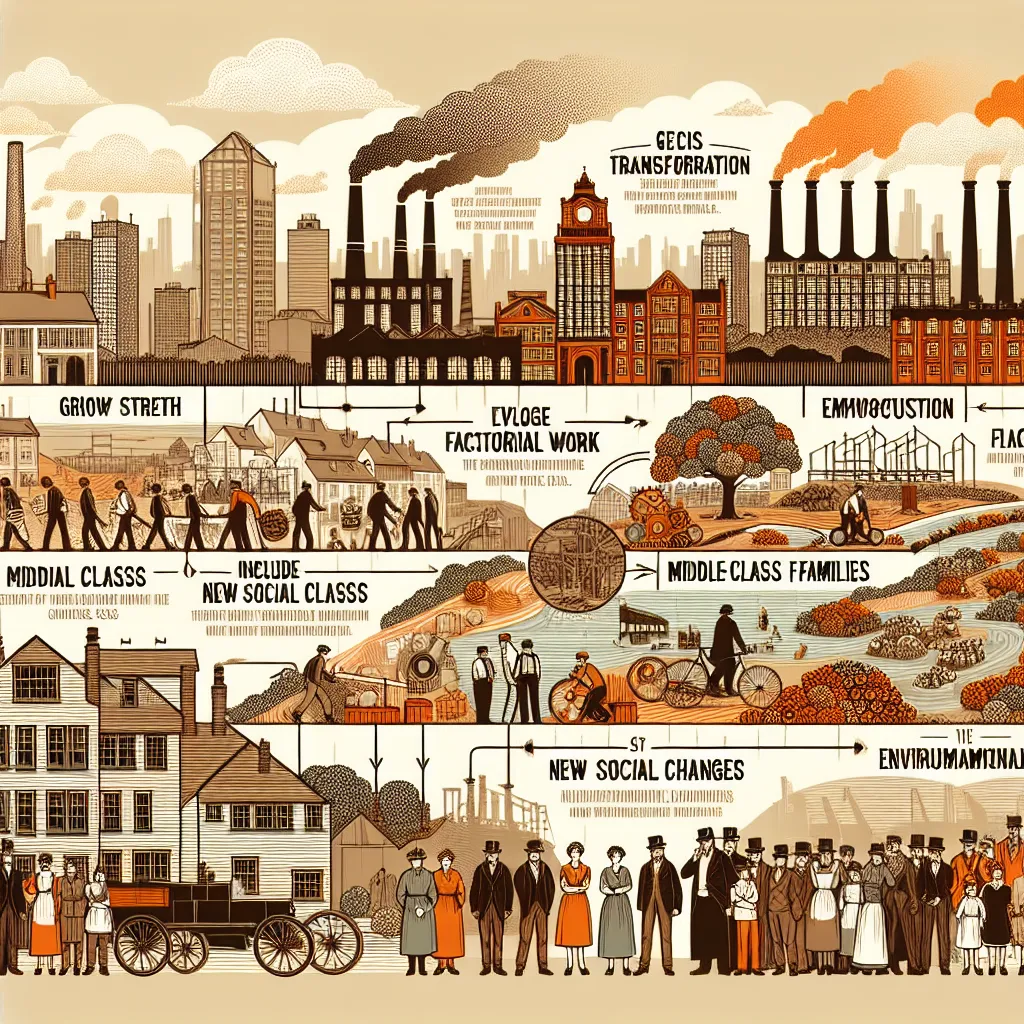The IELTS Reading section is a crucial component of the test, assessing your ability to comprehend complex texts and answer various question types. Today, we’ll focus on a topic that has appeared frequently in past exams and remains relevant: “The Impact of Industrialization on Social Structures.” This subject is not only historically significant but also continues to shape our modern world, making it a prime candidate for future IELTS Reading passages.
Based on our analysis of past IELTS exams, topics related to societal changes and industrialization have been consistently popular. Given the ongoing global discussions about sustainable development and social equity, we predict this theme will continue to be featured in upcoming tests. Let’s dive into a practice passage to help you prepare for this potential topic.
Reading Passage
The Transformative Power of Industrialization on Society
The Industrial Revolution, which began in the late 18th century, marked a pivotal moment in human history. This period of rapid technological advancement and economic growth not only revolutionized manufacturing processes but also fundamentally altered the social fabric of societies across the globe. The impact of industrialization on social structures was profound and far-reaching, reshaping communities, family dynamics, and individual lives in ways that continue to resonate today.
One of the most significant changes brought about by industrialization was the mass migration from rural areas to urban centers. As factories sprouted up in cities, they attracted a steady stream of workers seeking employment opportunities. This urbanization led to the rapid growth of cities, often outpacing the development of adequate infrastructure and housing. The result was the emergence of overcrowded, unsanitary slums where working-class families lived in challenging conditions. This urban concentration not only changed the physical landscape but also gave rise to new social classes and altered the traditional hierarchies that had long defined rural societies.
The factory system introduced by industrialization dramatically transformed work patterns and social relationships. Pre-industrial societies were characterized by small-scale, often family-based production, where craftsmen worked in their homes or small workshops. Industrialization shifted work to large factories, introducing a clear separation between the workplace and the home. This change had profound implications for family structures and gender roles. Men, women, and even children were drawn into factory work, disrupting traditional family dynamics and challenging long-held notions about the role of women and children in society.
Moreover, the rise of industrial capitalism created new social classes and exacerbated economic inequalities. Factory owners and industrialists amassed great wealth, forming a new upper class that rivaled the traditional aristocracy in terms of power and influence. At the same time, a large working class emerged, often facing exploitative working conditions, low wages, and limited social mobility. This stark division between the wealthy industrialists and the working poor gave rise to social tensions and eventually led to the formation of labor unions and workers’ rights movements.
The impact of industrialization extended beyond economic and social spheres, influencing education, healthcare, and governance. The need for a more skilled workforce led to the expansion of formal education systems, increasing literacy rates and providing new opportunities for social advancement. Public health became a pressing concern as urban populations grew, leading to improvements in sanitation and the development of modern healthcare systems. Politically, the concentration of workers in urban areas and the rise of labor movements contributed to the push for democratic reforms and expanded suffrage in many industrializing nations.
However, industrialization also brought significant environmental challenges. The rapid growth of factories and urban centers led to unprecedented levels of pollution, affecting air and water quality and public health. The exploitation of natural resources to fuel industrial growth began to strain ecosystems, setting the stage for the environmental concerns that would become increasingly prominent in the 20th and 21st centuries.
As industrialization spread globally, its impact on social structures varied across different cultures and regions. In some cases, it accelerated existing social changes, while in others, it clashed with traditional values and institutions, leading to complex processes of adaptation and resistance. The legacy of these transformations continues to shape our world today, as societies grapple with the ongoing challenges of technological change, urbanization, and economic inequality in the post-industrial era.
In conclusion, the impact of industrialization on social structures was revolutionary, altering nearly every aspect of human society. From the way people lived and worked to the organization of communities and the distribution of power and wealth, industrialization set in motion changes that continue to evolve in our modern, globalized world. Understanding this historical process is crucial for addressing contemporary social issues and envisioning sustainable paths for future development.
 Impact of Industrial Revolution on Society
Impact of Industrial Revolution on Society
Questions
True/False/Not Given
For questions 1-5, decide if the statements are True, False, or Not Given based on the information in the passage.
- Industrialization led to a decrease in the rural population as people moved to cities for work.
- The factory system improved working conditions for the majority of workers.
- Industrialization contributed to the expansion of formal education systems.
- All industrializing nations experienced the same pattern of social change.
- Environmental concerns were immediately addressed as industrialization progressed.
Multiple Choice
Choose the correct letter, A, B, C, or D.
-
According to the passage, one of the main consequences of urbanization was:
A) Improved living conditions for all city dwellers
B) The development of overcrowded slums
C) A decrease in overall population
D) Immediate improvements in city infrastructure -
The factory system’s impact on family structures included:
A) Strengthening traditional family roles
B) Eliminating the need for child labor
C) Separating the workplace from the home
D) Increasing leisure time for families -
The new social class that emerged to rival the traditional aristocracy was:
A) The middle class
B) Factory workers
C) Urban planners
D) Factory owners and industrialists -
Which of the following was NOT mentioned as an effect of industrialization on governance?
A) The formation of labor unions
B) Push for democratic reforms
C) Expansion of suffrage
D) Reduction in government regulation -
The passage suggests that the impact of industrialization on different cultures:
A) Was uniform across all regions
B) Only affected Western nations
C) Varied depending on existing social structures
D) Always led to immediate social progress
Matching Headings
Match the following headings to the correct paragraphs in the passage. Choose the correct heading from the list A-H for each paragraph.
List of Headings:
A) The Rise of New Social Classes
B) Environmental Consequences of Industrial Growth
C) The Global Spread of Industrialization
D) Urbanization and Its Challenges
E) Changes in Work and Family Life
F) Political and Educational Reforms
G) The Birth of the Industrial Revolution
H) Healthcare and Sanitation Improvements
- Paragraph 2: __
- Paragraph 3: __
- Paragraph 4: __
- Paragraph 5: __
- Paragraph 6: __
Answer Key
-
True – The passage states that industrialization caused “mass migration from rural areas to urban centers.”
-
False – The passage mentions “exploitative working conditions” for the working class.
-
True – The text states that industrialization led to “the expansion of formal education systems.”
-
Not Given – The passage doesn’t explicitly state that all nations experienced the same pattern of change.
-
False – The passage suggests that environmental challenges were not immediately addressed, but rather “set the stage for environmental concerns” in later centuries.
-
B – The passage mentions the “emergence of overcrowded, unsanitary slums.”
-
C – The text states that industrialization introduced “a clear separation between the workplace and the home.”
-
D – The passage refers to “Factory owners and industrialists” forming “a new upper class.”
-
D – Reduction in government regulation is not mentioned in the passage.
-
C – The passage states that industrialization’s impact “varied across different cultures and regions.”
-
D – This paragraph discusses the migration to cities and resulting urban challenges.
-
E – This paragraph focuses on changes in work patterns and family dynamics.
-
A – This paragraph describes the emergence of new social classes.
-
F – This paragraph discusses changes in education and political movements.
-
B – This paragraph focuses on the environmental impacts of industrialization.
Common Mistakes
When answering questions about complex topics like the impact of industrialization on social structures, students often make the following mistakes:
- Overgeneralizing: Assuming that effects were uniform across all regions or time periods.
- Misinterpreting cause and effect: Confusing the outcomes of industrialization with its causes.
- Overlooking nuances: Failing to recognize that some effects had both positive and negative aspects.
- Projecting modern perspectives: Interpreting historical events solely through a contemporary lens.
- Ignoring the ‘Not Given’ option: Inferring information that isn’t explicitly stated in the passage.
Vocabulary
- Pivotal: (adjective) /ˈpɪvətl/ – of crucial importance in relation to the development or success of something else
- Urbanization: (noun) /ˌɜːbənaɪˈzeɪʃn/ – the process of making an area more urban
- Exacerbate: (verb) /ɪɡˈzæsəbeɪt/ – to make a problem or bad situation worse
- Suffrage: (noun) /ˈsʌfrɪdʒ/ – the right to vote in political elections
- Exploitation: (noun) /ˌeksplɔɪˈteɪʃn/ – the action of treating someone unfairly in order to benefit from their work
Grammar Focus
Pay attention to the use of passive voice in academic writing, which is common in IELTS Reading passages. For example:
- “This period of rapid technological advancement and economic growth not only revolutionized manufacturing processes but also fundamentally altered the social fabric of societies across the globe.”
This sentence structure allows the focus to remain on the action and its effects rather than on who performed the action, which is typical in academic and historical writing.
Tips for IELTS Reading Success
-
Practice active reading: Engage with the text by predicting content, questioning the author’s purpose, and summarizing key points.
-
Improve your time management: Allocate your time wisely between reading the passage and answering questions.
-
Develop your vocabulary: Regularly learn new words and practice using them in context.
-
Focus on understanding the overall message: Don’t get stuck on individual words you don’t understand.
-
Use skimming and scanning techniques: Quickly identify main ideas and locate specific information.
-
Pay attention to transition words and topic sentences: These can help you understand the structure and flow of the passage.
-
Read the questions carefully: Ensure you understand what is being asked before searching for the answer.
-
Practice with a variety of question types: Familiarize yourself with all the different IELTS Reading question formats.
-
Review your answers: If time allows, double-check your responses for accuracy and consistency.
-
Stay calm and focused: Remember that with practice and the right strategies, you can improve your IELTS Reading score.
By following these tips and regularly practicing with passages on diverse topics like the impact of industrialization on social structures, you’ll be well-prepared for the IELTS Reading test. Remember, understanding historical and social themes not only helps in the test but also broadens your perspective on the world around you.
For more practice on related topics, you might find these articles helpful:
- What are the social effects of urbanization in developing countries?
- Historical analysis of colonial impacts on modern societies
- Historical events that shaped modern nations: Preservation of cultural heritage sites
These resources will provide additional context and practice for understanding complex social and historical topics, which are frequently featured in IELTS Reading tests.


